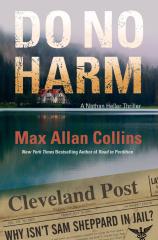Do No Harm: A Nathan Heller Thriller
Review
Do No Harm: A Nathan Heller Thriller
DO NO HARM, the latest installment in Max Allan Collins’ Nathan Heller series, is of particular interest to me. It concerns the Sam Sheppard murder trials. A suburban Cleveland physician, Sheppard was confined to the Ohio State Penitentiary in Columbus for over a decade after being convicted of his wife’s murder. I grew up hearing in real time about the first trial in 1954 while living in Columbus, Sheppard’s court-ordered release, and his retrial in 1966 while living near Cleveland. So I expected quite a bit from this book. I got it all, and more.
Nathan Heller is a private investigator who, over the course of several novels set in the era of the mid-20th century, has nurtured his Chicago-based A-1 Detective Agency into a multinational presence. He seems to know everyone worth knowing, and they know him as well. In DO NO HARM, Heller is a guest in the Cleveland-area home of Eliot Ness for the Fourth of July weekend when Marilyn Sheppard is found murdered in one of the bedrooms of the Bay Village home that she shares with her husband. Ness is called to the scene and brings Heller with him, enabling the latter to see the murder scene firsthand and get an impression of the principals involved on both sides of the investigation.
"DO NO HARM is extremely impressive. Collins is always a stickler for detail, but he reaches new heights in this work, particularly when describing what Cleveland was, from its well-known landmarks to its less famous but still interesting elements."
Dr. Sheppard, always described as “the Bay Village osteopath,” is immediately identified as a suspect, and is tried and convicted in the news media. The guilty verdict is a foregone conclusion; as a result, Sheppard, despite his multiple and consistent protestations of innocence, is in a prison cell before the year is out. In DO NO HARM, the case attracts the attention of author Erle Stanley Gardner, who retains Heller to investigate the matter with the intent of persuading the powers-that-be to permit Sheppard to undergo a lie detector test. However, the fix is too far in for Heller to be effective in this endeavor, notwithstanding his discovery of possibly exculpatory evidence.
But wait, there’s more. Noted defense attorney F. Lee Bailey takes the reins of the Sheppard defense team in the early 1960s and is able to get him set free, only for him to face a retrial in 1966. Bailey, who has worked with Heller before, retains him to gather new evidence for the defense in the retrial. History tells us, of course, that Sheppard was found not guilty this time. But Collins tells us more in the sense of what may and might have been. As for reaching a conclusion? You’ll have to read the book to draw your own.
DO NO HARM is extremely impressive. Collins is always a stickler for detail, but he reaches new heights in this work, particularly when describing what Cleveland was, from its well-known landmarks to its less famous but still interesting elements. To this day, one can still see the remnants of some of the haunts and locations that Collins so vividly describes, particularly the downtown restaurants and bars that are no longer there but are still visible, creating a sort of urban palimpsest.
As for Sheppard, he is long dead, but there are still people --- myself included --- who were alive when all of this went down and will vociferously argue for his guilt or evidence, with positions changing over time. Sheppard’s legacy includes a television series “The Fugitive,” later made into a movie, which may or may not have been based on the infamous case, but both were certainly close enough for government work. Read DO NO HARM and decide for yourself.
Reviewed by Joe Hartlaub on May 1, 2020
Do No Harm: A Nathan Heller Thriller
- Publication Date: March 10, 2020
- Genres: Fiction, Historical Fiction, Historical Mystery, Historical Thriller, Mystery, Suspense, Thriller
- Hardcover: 304 pages
- Publisher: Forge Books
- ISBN-10: 0765378299
- ISBN-13: 9780765378293




